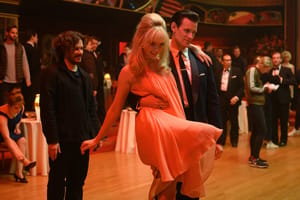
“I sort of have this ongoing fantasy, like a lot of people do,” says Edgar Wright, director of Last Night in Soho. “And I don’t know whether it’s a fantasy or a malaise or something, where you just think about going back in the past, all the time. But then I think it’s always tempered with the knowledge that yes, it might be great to go back. But that doesn’t mean that everything was great then.”
As Thomasin McKenzie, who plays the protagonist of the film, puts it: “Nostalgia is a funny thing.”
It’s something Wright has always thought about, in 25 years of walking around Soho, seeing restaurants and clubs change even as the buildings stay the same. Strip clubs and dirty bookstores have given way to shoe-store chains. Packed record stores have turned into spacious restaurants. The Marquee, where Jimi Hendrix, Led Zeppelin and David Bowie played early shows, has been converted into lofts.
“You can’t help but think about what these walls have seen in any building that you’re in, that’s 100 years old, or hundreds of years old,” says Wright.
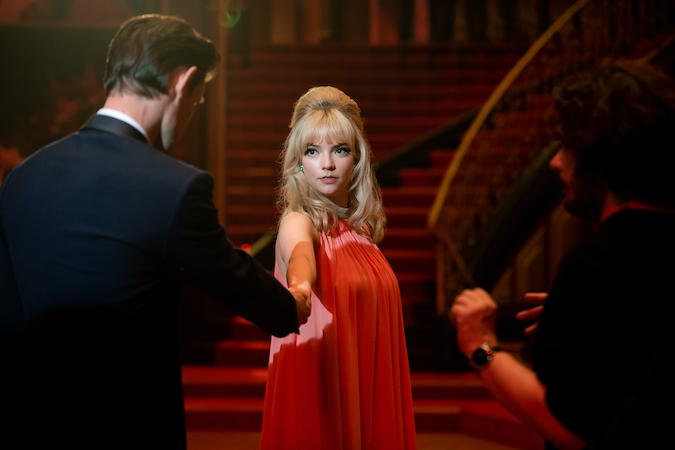
Actors Anya Taylor-Joy and Matt Smith with director Edgar Wright on the set of Last Night in Soho. Photo Credit: Parisa Taghizadeh, Focus Features.
Last Night in Soho is a grand, sweeping, elegant time warp of a film, set to arrive in theaters after many months of many people saying big movies are over. Wright began kicking around the idea for the film around 2013, then co-wrote the script with Oscar-nominated 1917 screenwriter Krysty Wilson-Cairns, and began shooting it before the pandemic. When the streets went silent for a while, Wright seized on the opportunity to photograph one of the most celebrated neighborhoods on earth in empty stasis. Then the film did reshoots, and theaters reopened, and Wright saw a film in a theater for the first time in months, but not a new movie: A 35mm screening of Brian De Palma’s 1981 Blow Out, inspired by Michelangelo Antonioni’s Blow-Up, a film set in a swanky-to-seedy 1960s London milieu similar to that of Last Night in Soho. Time keeps collapsing in on itself, never more than in the recent past. We look to the future and hope for the past. McKenzie turned 19 during filming, 20 during reshoots.
Listen to our interview with Last Night in Soho co-screenwriter Krysty Wilson-Cairns on Apple or Spotify or right here (story continues after):
McKenzie plays Eloise, who is exactly her age, a young woman who grows up in a rural area of England, raised by her grandmother and obsessed with the 1960s. She gets a chance to study fashion in London, but feels wildly out of place with her trend-chasing fellow students. So she rents a room with neon light flashing through her window from a strict landlady (the late Diana Rigg, magnetic in her final screen role). Eloise soon discovers a dreamy passageway into the Soho of decades past, in which an aspiring singer named Sandie (Anya Taylor-Joy) falls for a mystery man (Matt Smith) who promises to make her own dreams come true. Eloise and Sandie begin to mirror each other, in every sense.
“They’re on parallel journeys of going to the big city with big expectations, big hopes,” says McKenzie. “And then reality hits them in the face.”
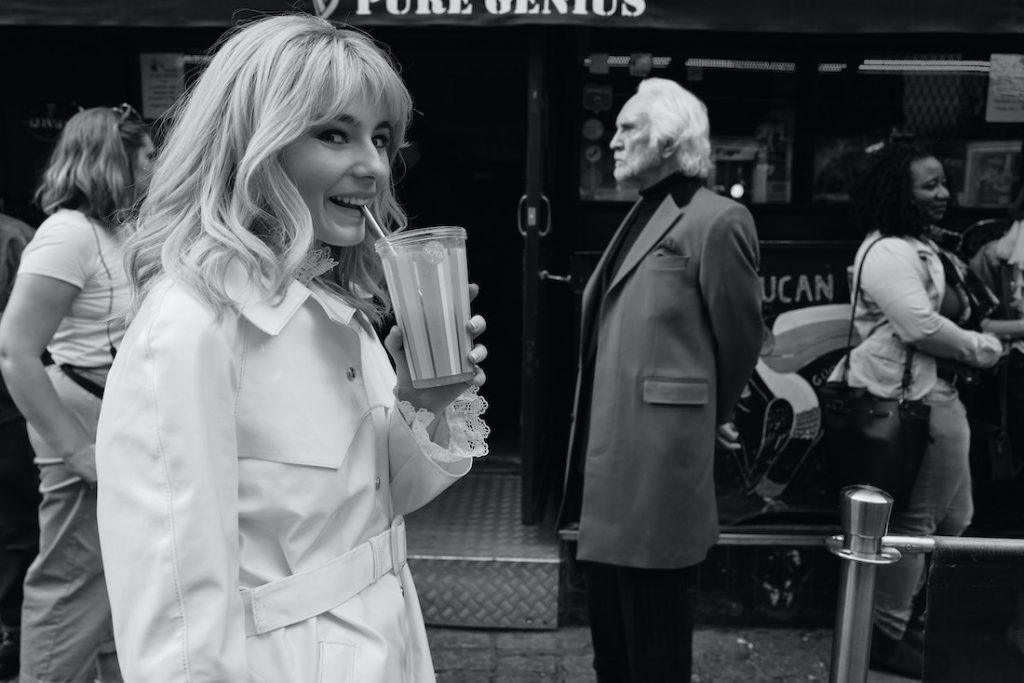
Thomasin McKenzie and Terence Stamp on the set of Last Night in Soho, from director Edgar Wright. Photo by Greg Willams
Getting Lost
“It’s the problem of nostalgia that nostalgia generally tends to romanticize the past,” says Wright. “And I think, you know, obviously the ‘60s is a decade that’s probably the most-discussed decade of the 20th century, and probably one of the most romanticized ones as well. … It’s a cautionary tale about nostalgia itself: If you could go back, should you go back? That’s essentially what the film is.”
Edgar Wright
Nostalgia has of course fueled many of Wright’s passionate, glorious-looking films: At 20, he made the Western A Fistful of Fingers for a reported $15,000. He returned to filmmaking with 2004’s Shaun of the Dead, paying homage to George Romero’s zombie masterpiece Dawn of the Dead, and his other collaborations with Simon Pegg, 2007’s Hot Fuzz and 2013’s The World’s End, usurped and honored the buddy-cop and sci-fi genres, respectively. The 2010 comic-book adaptation Scott Pilgrim vs. The World was a love letter to rock music that featured many of the next decade’s breakout stars; and Baby Driver was a crackling heist movie that timed its car chases to smoldering rock, soul and R&B, like a 90 mph DJ set through shortcuts and back alleys.
Won’t You Take 1o Seconds to Sign Up for Our Newsletter?
Last Night in Soho is a slow burn that lets us luxuriate, for a while, in the lovely dream that things used to be simpler. But the film’s elegantly calibrated shifts quickly dispel that notion.
“It was such an insane journey for that character,” says McKenzie. “And this is the only time I’ve ever had to do this: I had to write out a timeline for myself. And I would go through it and check off the scenes that we had done. Because it was so — I don’t know how Edgar did it. It’s just so many shots. So much went into creating this movie that it was so easy for me to kind of get lost in it. So I really had to be diligent in making sure that I knew exactly what scene it was, exactly what shot it was, exactly where my character was, every single day, because it was just so, so mad. There was so much going on.”
Wright offered his cast a long list of 50 movies to help set the tone, including horror films, dramas and documentaries from the 1960s and around the decade. McKenzie laughs that she isn’t a horror fan, but enjoyed the challenge of making her way through the list.
“It was educationally really great because it exposed me to things that I hadn’t ever watched before,” she says. “I watched Rosemary’s Baby and Don’t Look Now and really obscure ones like Beat Girl.”
Beat Girl is one of several movies in a genre that came to fascinate Wright: a spate of 1950s and ’60s British films in which an ambitious young woman tries to make it in the big city, with dreadful consequences.

Edgar Wright (R) directs Matt Smith and Anya Taylor-Joy on the set of Last Night in Soho. Photo by Parisa Taghizadeh/Focus Features.
“Once I had the idea for this film, rather than watching a lot of psychological thrillers and horror movies, I was sort of more watching a lot of dramas of the time, like social dramas,” Wright recalls. “And there’s a big sort of subgenre of films, especially British films, about young girls going to London. And having the temerity to want to do well in show business and being roundly punished — usually by a male writer. So it felt like it was like a stinging rebuke against women’s liberation, this idea of, How dare you want to come to the city and make it big?
“And there’s many, many films like that, which I thought was so interesting and quite dark in itself, in terms of, Who are these films for? It almost felt like the old guard trying to slap down the younger generation. And so in that sense, there’s an element with Soho where you get to watch two of those movies— one in the modern day and one in the past. So the idea of having twin narratives in two decades was really fascinating to me.”
The whole cast and crew knew about the 50 films, but McKenzie stood out in her commitment: “I wasn’t expecting her to watch all 50 but I think she did,” Wright laughs.
Thomasin McKenzie
Immersion is a Thomasin McKenzie trademark. Since starting as a child actor a decade ago, she’s amassed a near-impeccable list of credits, characterized by her hyperreal, unfussy performances. Wright knew her from Debra Granik’s magnificent, rooted, every-moment-earned 2018 film Leave No Trace, which drew comparisons between McKenzie’s work and Jennifer Lawrence’s breakthrough in another Granik film, 2010’s Winter’s Bone.
“She’s so utterly naturalistic in that that I wasn’t even sure whether she was an actress,” Wright says of McKenzie in Leave No Trace. “Her performance is like you almost might be watching a documentary, with that film.”
She brought a similar groundedness to Taiki Waititi’s fantastical 2019 film Jojo Rabbit, in which she played a Jewish girl who inspires an aspiring Nazi to reject Hitler. As she spoke to MovieMaker from her home in her native New Zealand, she was also doing press for M. Night Shyamalan’s summer horror film Old, and she will also appear this fall in Jane Campion’s The Power of the Dog.
McKenzie disappears into roles so completely that Wright didn’t realize she had a New Zealand accent.
“It’s just a bit of alchemy for the film that Thomasin is somebody who’s not from the U.K., and certainly not from London, who is coming to London, to go on a journey to play this part and then sort of going on the same journey as Eloise,” Wright says. “And I think there’s a lot of that that comes out in the movie —she’s in like every scene of the movie. And you’re living the movie through her subjective experience. … I think her performance is made even more compelling by the fact that she’s in a strange way living it, you know?”
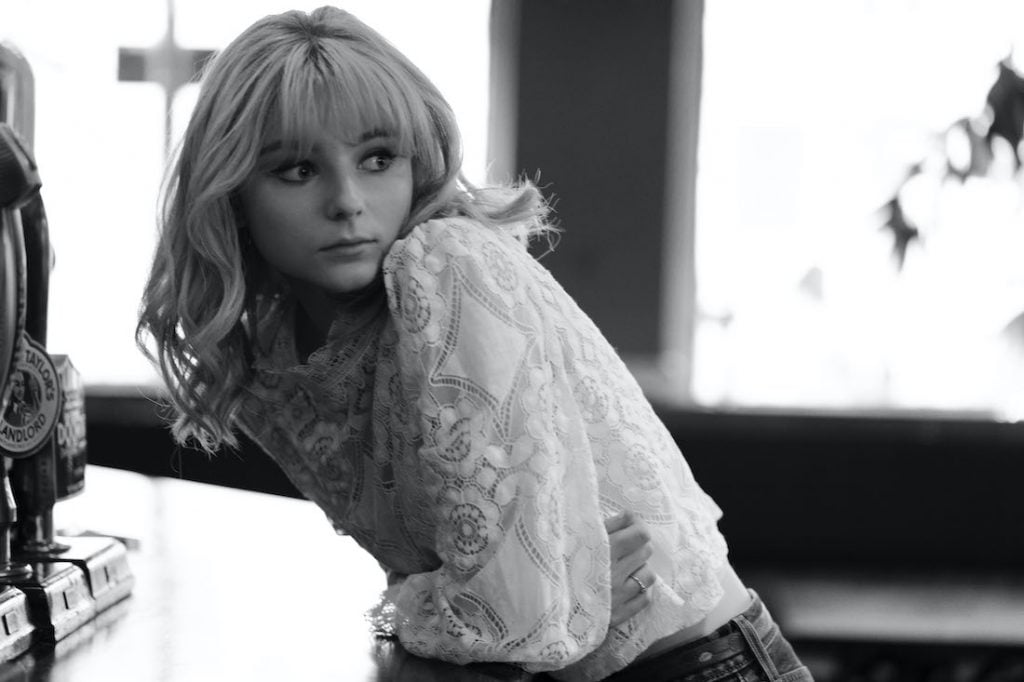
Thomasin McKenzie on the set of Last Night in Soho, from director Edgar Wright. Photo by Greg Williams. Main image (above): Anya Taylor-Joy and Matt Smith with Edgar Wright on the Last Night in Soho set. Photo by Parisa Taghizadeh/Focus
Last Night in Soho is filled with cinematic spectacle, from the gorgeous to the garish, and Eloise’s journey takes labyrinthine turns. But we stay rapt, because the protagonist feels so genuine. McKenzie left thoughts of genre behind when she took on the role of Eloise, and tried to just inhabit her.
“I don’t think I treated it like a horror movie or like a drama,” she says. “I took it seriously. I didn’t want to be playing as if it was horror or playing as if it was a psychological thriller. My method was just, This is what is happening to my character. And this is her real life.”
Anya Taylor-Joy and Matt Smith had to play it very differently. Both earned excellent notices for their recent roles in Netflix stories set partly in the ‘60s: He as Prince Philip in the first two seasons of The Crown, and she as fictional chess genius Beth Harmon in lockdown-era sensation The Queen’s Gambit.
Wright modeled their performances and storylines in part on the scoldy social dramas that had fascinated him — about young women daring to want it all. Taylor-Joy and Smith’s arc is similar, for example, to that of the central, wincing relationship at the heart of the 1957 British film The Flesh Is Weak, one of Wright’s reference points. In that film, and Last Night in Soho, a relationship begins with read-between-the-lines flirtation, then turns explicitly sinister.
“It was interesting for Matt and Anya, who are in the ’60s scenes, to look at those films just in terms of performance, because they thought it was something where you could contrast the performance styles between the modern-day scenes and the ‘60s scenes,” says Wright. “It’s sort of a different way of acting in those films… and I wanted to kind of subtly show that, which I think they did brilliantly.
“It’s almost like Matt and Anya were approaching it from the idea of movie actors at the time. Whereas Thomasin, in the modern day, is adopting a more naturalistic approach. That’s not to say that what Matt and Anya are doing is not believable. But because it’s in the sort of ’60s portion of the film, it’s more in the style of those dramas of the time.”
The two acting styles come together — majestically — in the first scenes between Eloise and Sandie, when McKenzie and Taylor-Joy move in perfect imitation of one another.
“I did feel like throughout the shoot, it did feel like Anya and I were really intertwined, because a lot of the scenes we were in together, we were literally mirroring each other,” McKenzie says. “That was one of the challenges of the kind of choreography of the shoot… the physicality of rehearsing having exactly the same movements in the same timing and even the same finger positioning. That was a really quite exciting, new experience for me. … The choreography of it gave the characters a similar vibe, or kind of a feeling of like them both being intertwined with each other.”
Wright initially thought Taylor-Joy might play the modern-day Eloise, after seeing her in Robert Eggers’ The Witch when he was a Sundance juror in 2015. He told her about the idea in a general meeting.
“So after three years of feeling like the boy who cried wolf and promising a script that never arrived, I said, ‘I’m sending you the Last Night in Soho screenplay. And one twist, I would like you to read the part of Sandie, and not Eloise,’” Wright recalls. “And to my delight, Anya got back in touch and said, ‘I read it, I love it. I want to do it and I want to play Sandie.’ Like, great! Now who’s gonna play Eloise?”
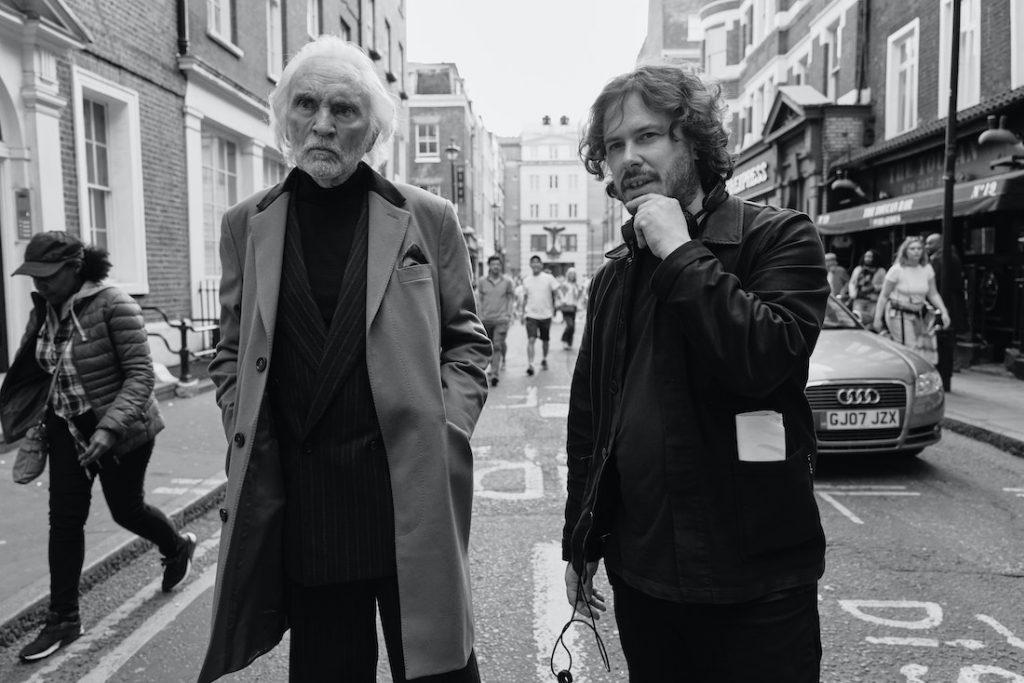
Terence Stamp and Edgar Wright on the set of Last Night in Soho. Photo by Greg Williams
Continue for more of Edgar Wright and Thomasin McKenzie on Last Night in Soho
Share:

